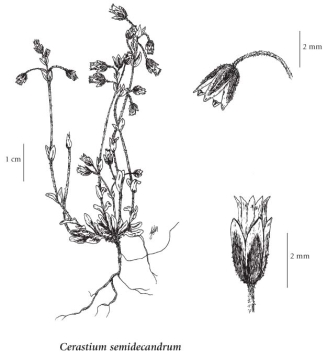Cerastium semidecandrum L.
little chickweed (fivestamen chickweed)
Caryophyllaceae (Pink family)
Introduction to Vascular Plants
little chickweed (fivestamen chickweed)
Caryophyllaceae (Pink family)
Introduction to Vascular Plants
Species Information
General:
Annual herb from a slender taproot; stems erect to ascending, branched, hairy, sometimes glandular, 1-20 cm tall.
Leaves:
Basal leaves oblanceolate with a stalk-like base; stem leaves opposite, egg-shaped to elliptic-oblong, 5-18 mm long, white-hairy; stipules lacking.
Flowers:
Inflorescence in a spreading cluster; flowers stalks at first sharply deflexed at the base, later almost erect, glandular-hairy; petals 5, white, narrow, 2-4 mm long, slightly notched; sepals 5, narrowly lanceolate, sharp-pointed, 3-5 mm long, glandular-hairy, broadly papery-margined.
Fruits:
Capsules cylindric, 4.5-6.5 mm long, 10-valved; stalks of the fruits curved downwards at first, later almost erect; seeds yellowish-brown, 0.4-0.6 mm long. vol2_6
Illustration

If more than one illustration is available for a species (e.g., separate illustrations were provided for two subspecies) then links to the separate images will be provided below. Note that individual subspecies or varietal illustrations are not always available.
Illustration Source: The Illustrated Flora of British Columbia
Ecology
Ecological Framework for Cerastium semidecandrum
The table below shows the species-specific information calculated from
original data (BEC database) provided by the BC Ministry of Forests and Range.
(Updated August, 2013)
The table below shows the species-specific information calculated from
original data (BEC database) provided by the BC Ministry of Forests and Range.
(Updated August, 2013)
| Site Information |
Value / Class |
||
|
Avg |
Min |
Max |
|
| Elevation
(metres) |
950 | 850 | 1050 |
| Slope
Gradient (%) |
46 | 35 | 59 |
|
Aspect (degrees) |
206 | 175 | 235 |
| Soil
Moisture Regime (SMR) [0 - very xeric; 4 - mesic; 8 - hydric] |
2 | 1 | 3 |
| Modal
Nutrient Regime
Class |
D | ||
| #
of field plots species was recorded in: |
3 | ||
| Modal
BEC Zone Class |
PP | ||
|
All BEC Zones (# of stations/zone) species was recorded in |
IDF(1), PP(1) | ||
|
Source:
Klinkenberg 2013
|
|||